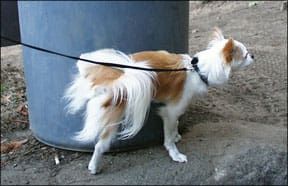Marking is not the same behavior as “my bladder is full and I have to pee.” Housetraining is just a matter of teaching your dog when and where to relieve himself. In contrast, marking is primarily a stress- or anxiety-related behavior, far more complex and challenging than housetraining. An occasional female will mark, but the culprits here are primarily male dogs. Here are five suggestions for dealing with marking behavior:
1.)Manage your dog’s behavior with closed doors, baby gates, leashes, crates, and exercise pens so he doesn’t have the opportunity to mark in another room undetected. If you catch him “in the act,” interrupt him with a cheerful “Oops!” and take him outside. While marking is not the same as housetraining, you can still send him the message that he’s allowed to mark outdoors, but not indoors.
2.)Reduce his stress levels. Identify and remove as many stressors as possible. This includes eliminating the use of aversives in training or behavior modification and removing known stressors from his environment, as well as counter-conditioning and desensitization to stimuli that trigger fear, anxiety, arousal, or aggression responses in your dog. Hence the importance of not using verbal or physical punishment or trying to frighten him if you catch him in the act; you’ll be adding stress, and could actually increase the marking behavior as a result.

Other useful tools for stress reduction include calming massage; aromatherapy; Comfort Zone (DAP, a synthetic substance that mimics the calming pheromones emitted by a mother dog when she’s nursing puppies); and Through a Dog’s Ear – a CD of classical music specifically selected for its calming effects on dogs.
3.)Thoroughly clean any soiled spots with an enzymatic product designed to clean up animal waste. Use a black light to find untreated spots. This will help you find undetected soiled spots from your own dog as well as dogs who may have lived in your home before you and your dog moved in – a common trigger for marking. Do not use ammonia-based products to clean! Urine contains ammonia and the ammonia in the cleaning products may actually inspire your dog to urinate on the spot where the ammonia-based product was used.
4.)Get him neutered. While this doesn’t always reduce or eliminate marking, it can help, especially if done sooner rather than later. Testosterone can be a significant stressor, particularly if there are females in season and/or other male dogs in the neighborhood.
5.)Use a belly band. This is a soft band of cloth with a Velcro fasterner, which you can wrap around your dog’s abdomen. For some dogs, the band inhibits marking behavior entirely. Others will happily soil the belly band, (you can attach a self-adhesive absorbent feminine pad to the inside the band to absorb the urine) but at least it protects your home environment from urine stains and odors. Change the pad as needed.
Note:Veterinary behaviorist Dr. Nick Dodman of Tufts University suggests that well-practiced marking behaviors can often only be resolved with the use of behavior modification drugs. If you are not successful in your efforts to modify and manage your dog’s marking, make an appointment with a behavior-savvy veterinarian to discuss the possibility of using anti-anxiety medication.
Your vet can also consult with a veterinary behaviorist elsewhere in the country by phone. You can find contact information for veterinary behaviorists at dacvb.org or avsabonline.org.
Pat Miller, CPDT, is Whole Dog Journal’s Training Editor and author of many books on positive dog training. See page 24 for book purchase and contact information.






